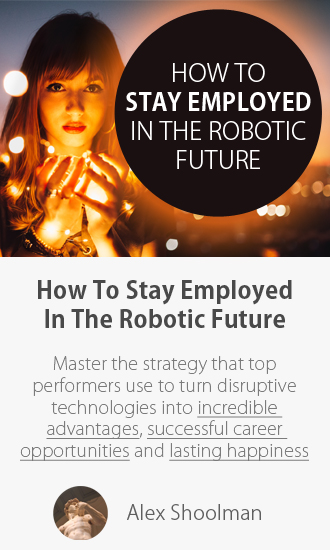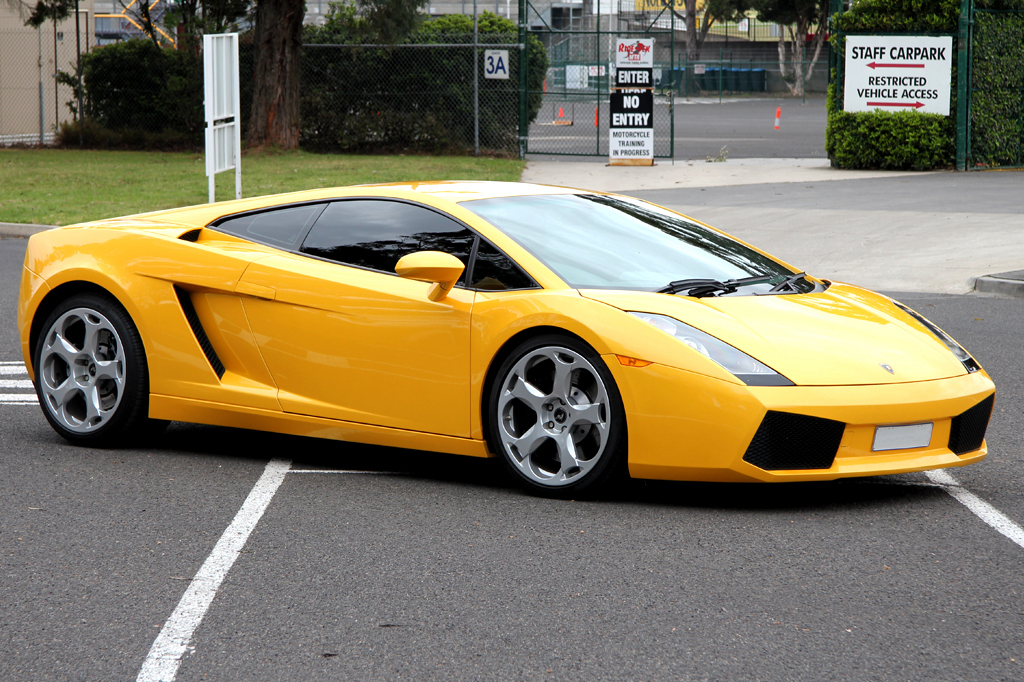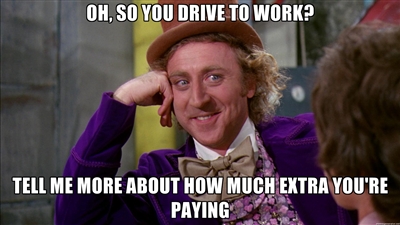This is an extremely detailed series of posts that applies not only to First Home Buyers, but also to existing home-owners. The point is to cover the most major expenses and how to make sure that your mutilation powers are at their highest with all of them. You want details? Read these!
This is normally the highest cost for most people. No, not the Lamborghini, I’m talking about the cost of transportation. The above picture was taken just after an hour long joy ride I had which was indeed a ball. The acceleration of the car was fantastic and the constant stream of people staring, pointing and taking photo’s was quite unexpected. Unfortunately though, like many fantasies, owning one of these beautiful cars is a pain in the ass. You might scoff at this statement thinking I don’t know what I’m talking about… but this isn’t actually MY view, it was the OWNERS view! Whilst driving around we talked and I queried him about how much it cost and what it was like to own such an iconic “dream car”. The reality is there’s very little room for bags/things, there are only 2 seats, it gets terrible fuel economy, you can’t park/leave it anywhere for fear of someone damaging it and the repair costs are insane! My point is that transportation is often idolised and highly sort after, but to me I can’t help but constantly be reminded of how it just never lives up to its hype. One of the biggest things I could never understand is that manufacturers spend so much time making the outside of the car look good… and yet never spend much time making the interior look nice. This means that you’re effectively paying lots of money to give OTHER people a pretty view, all you get is to see the often boring interior all day long! But enough of my ranting let’s get into the details. You’re here to find out how to setup shop with the lowest possible Transportation costs so let’s dig in.
For those that haven’t bought their first home just yet, lucky you! You can get this excellent advice ahead of time and ensure that your home is as close as possible to your place of work.
Commuting takes time, is dangerous the longer you do it and also costs you money in many different ways (the car, petrol, rego, insurance, repairs, servicing, parking, tickets and so on). It is also constantly getting worse and worse as Australia fills up with people and the roads or public transport systems get more cramped. Some people over in the US suggest purchasing your house so close to your work that you can walk there and back (say <5km’s or so). Others suggest that it be within biking distance however few of these people live in giant sprawling cities such as Melbourne or Sydney. These two locations are not only two of the world’s biggest cities, they are also two of the most unaffordable cities in terms of house prices versus wages. These two factors combine to make up an extremely evil scenario in that in order to buy close to your work (which is highly likely to be in the CBD area’s) you have to pay outrageous prices often for small, 2 bedroom apartments (like say this one at $440,000). If you want a more modest mortgage amount then you have to go further out increasing your commute time. You just can’t win! Except you can win, it’s all just about how you frame the decision. Early Retirement Extreme makes for a very persuasive case right here in fact. For him, retiring that much earlier was more important than owning a car. For most in Australia I’d imagine that at least 1 car is needed as our public transport isn’t as good as other countries and the distances involved for commuting are so large quite often. However how MUCH you drive can be reduced significantly if you start to prioritise which means more to you, paying off that mortgage quicker… or sitting in traffic every day. There are also a number of other options to consider.
Table of Contents
Work
Now as above, there’s often not much you can do about living closer to your work. Even if you’re not a daily CBD commuter and your job is in the outer suburbs, chances are that you’ll be changing jobs every 2-4 years given how antsy most people are with companies these days. You don’t work for “Big Corp” for 40 years and then retire any more, you work there for 2 years then move… then at another place for 4 years then move… and so on. So when your job moves, your commute may go up or down. A general bit of advice for this is to begin trying to choose your future employment with a higher focus on their commuting distance. You may do this already a little, but try and make it one of the top priorities to be close to your work. It should also be the same deal when buying your next home (or your first). Find your job, draw a 5 km or 10-20 km radius around that location depending on whether you’d like to walk or bike and start seeing what you can find.
If finding a place that’s nice and close honestly isn’t an option (seriously give this a GOOD investigation though before claiming “it can’t be done”) then there are still other options to at least reduce the costs of commuting to work, even though it will still take up your precious time every day. First off there’s public transport. Yes it’s nowhere near as awesome as places like England or Paris but none the less it will get you there for cheaper than a car. You don’t have to pay for petrol, parking, servicing and maintenance and you can read these wonderful posts while you’re commuting. You can also sleep, munch on some breakfast or brush up on some other skills by reading more. It is also safer and better for the environment. If you’re worried about “peak hour” a good trick to get used to is simply arriving at work earlier and leaving earlier. Not all employers will allow this but even an hour earlier can make a huge difference to getting a seat and being on a much quieter train. To make taking public transport even easier, you should consider where the bus stops and train stations are before you buy. I like to shoot for a <2km range to the nearest station as it’s easy to walk, meaning a car isn’t needed at all to get to work. It’ll also mean your car will be safe and sound at home, not to mention it saves you from hunting for a car park every morning. One final note is that when choosing a house, be aware of which station it’s near. There are good stations and there are bad stations. You’ll likely have to drive around it a bit to get a feel but I like to still feel safe walking home at night time from a station. A good station will also likely indicate a safer and thus more sort after suburb too.
A completely different option that more and more people are taking up is biking there and back. It will not only be cheaper than public transport, but it will get you healthy pretty quick given the decent distances you’ll likely be riding each day. A biking commute of 25km’s each way isn’t unheard of in Australia, which translates to around 250km’s/week. When you bike, exercise expenses will be greatly reduced making for even more savings. Then there are the health benefits, the further reduction of your carbon footprint and finally the fact that it’s just plain fun I think. When we first moved in to our new house both DW and I had our own cars, now one of them is getting more and more obsolete. Eventually my hope is to sell it off, bike or catch the train most of the time and just live with one car that isn’t used too often. For now I’m trialling the biking part and it seems to be going quite well, I just hope that the fun level stays where it is and that I can handle the lifestyle reduction without any issues. I’d hate to be a hypocrite and suggest you do something I can’t even do!
As a final note, I’d just like to throw out there some very basic figures on what choosing to commute in a car over a bike will likely cost you. The ATO puts a 1.6-2.6 litre car at costing $0.74 / km. Driving 25 km’s per day to and from work, 5 days a week, 48 weeks per year comes out to be $0.74 * 25 * 2 * 5 * 48 = $8,800 / year or $170 / week. This figure appears to cover all costs of the car such as rego, repairs, services, fuel etc. If you were to instead throw that extra money at your mortgage (say a $400,000 one at 6%) it will take a considerable amount off the loan term. If you’re paying the minimum amount ($550 / week) on a 30 year loan, the increase to $720 / week will cut 13 years off your loan and save you $286,465 in interest. Even if you’re being super keen (as you should be) and paying double the minimum repayments ($1,100 / week), increasing this to $1,270 / week will take your loan term from 9 years down to 7.5 years and save you $20,944 in interest! This is also the savings that are made by eliminating 1 commute, the savings compound if BOTH of you ditch the car!
So how does riding a bike to work sound now? If you had to put a monetary value on it… what would you come up with? In that last case paying off your house in 7.5 years instead of 9, it’d save you $20,944 in interest + 7.5 years * $8,800 = $86,944.
Shops / Groceries
Next up is the transportation to your shops or grocery outlet. At first I never really paid too much attention to this matter as quite often these things aren’t very far away relative to our work environments. One might be a 1.5 hour commute in hell traffic while the other is only a 4 km drive away. But when you multiply out how many times you might go to the shops the costs once again seem to add to a decent amount. The other fact that makes this a good area to investigate and cut down on is because holding off on popping down to the shops really isn’t that hard of a thing to do. So if it’s not hard to do and can save you a decent amount of money… why not do it!? How much money you ask? Well some quick calculations for someone who reduces going to the shops maybe 4-5 times a week to just 1 would be 4 * 4km’s * 2 = 32km’s each week. Again taking the ATO’s value of $0.74 / km, it will cost you about $23 / week extra. That’s over $1,230 / year just for cutting down on your shopping visits. Now you may scoff at anyone that visits the shops 4-5 times per week (maybe you go even more often), but the goal should be to essentially NEVER drive to the shops for the sole reason of buying things. You might not achieve it, but at least you’ll be cutting down on wasted costs.
Now this isn’t the biggest saving in the world (although I’d take $1,230 any day personally), but you can hopefully see that it’s a good habit to get in to right from the start and shouldn’t bring about too much troubles either. Some good ways I’ve found to help this philosophy along is to purchase meats or other fresh vegetables on the way home from work (shops are often near the stations) or even pop into a supermarket whilst driving back home from another event (say a visit to a friends or parents’ house). This way you’re never specifically going out to do grocery shopping, it’s always built into your other driving that you’d likely do regardless. Further action you can take is to make sure your new property is well within walking distance of a supermarket or general shops. I’d probably aim for around the <2km mark so it’s not too much of a hike with a heavy load of food you’re carrying. For us, we rarely step out of the house specifically to shop any more. Food is either purchased on the way home from other events or we’ll walk/bike to get smaller things locally.
The Actual Car
Finally let’s just generally discuss the car. You may already have one, it might be a bomb or it might be a brand new super massive V8 monster, either way there are loads of things you can do to reduce your costs. The most obvious but often over looked one is to simply drive less. We all should be doing this even if it doesn’t save us money, if you don’t think so, have a movie night with An Inconvenient Truth then hopefully you’ll get the picture. I love driving cars fast and love cruising along on a gleaming summers day… but it should all be in moderation and if this good act helps pay off my mortgage quicker too, then I’m all for it! Now in America they are extremely set on Leasing and Financed brand new vehicles that are often well… basically the equivalent of trucks (the best selling cars for June 2012 in the US was the Ford F-Series like this one). They’re massive and just chew threw the petrol non-stop. Here is Australia we seem to have some very good low fuel consumption cars and for the most part, a lot of them seem to be in the top 10 best sellers, however we also seem to be quite big fans of 4WD’s as I see them cruising around a lot now a days. This topic can get very heated, very quickly so I will try and stick purely to the facts by choosing a very common Australian choice in car, the 2012 Holden Cruze CD JH Series II (Sedan) versus the 2012 Holden Captiva 5 CG Series II (a “4WD” although it’s technically only FWD):
- The 4WD costs more to buy (sedan was $21,490 vs. the 4WD which was $27,990)
- The 4WD uses more petrol than the sedan (7 L/100km for the sedan vs. 8.8 L/100km for the 4WD)
- The 4WD is LESS safe than the sedan which is a very common misconception (the sedan scored 35.04/37 vs. the 4WD which scored 34.32/37)
- Being higher up makes it harder to judge your speed leading to more risky driving and likely more speeding fines
Conclusion: The two studies demonstrate that, when they are not able to reference a speedometer, drivers choose to drive faster when they view the road from an eye height that is representative of a large SUV compared to that of a small sports car.
Clearly the sedan is the better option (based on facts not feelings which I do acknowledge comes into play with cars). That said though even hatches I believe are a better off choice, especially for young people wanting to pour as much as they can into their mortgage instead of yet another petrol bill. Hatches take the bar up yet another notch with another common car being something like the 2012 Toyota Corolla Ascent ZRE182R. With this you’ll get:
- Even cheaper still at $19,990
- Around the same petrol use (7.1 L/100km)
- An even better safety rating of 35.25/37
- A lower view that promotes slower driving not to mention better handling
Further still (as with most finance blog recommendations) I’d suggest that the idea of buying a new car be firmly kicked out the window. Leasing a car or salary sacrificing it should also be ditched as these only apply to new or newish (4 years or less) cars. What we’re after may fall into the 4 year old mark, but more than likely you should be looking for something around 5-6 years old. Now I’m by no means a car expert so obviously this number will vary depending on the make/model of the car you’re investigating. Some manufacturers are more reliable than others and some cost more to repair than others. Then again some cars devalue VERY quickly and can make for a great deal. To be clear, that 5 year figure should be taken as a guide rather than a strict statement. You want to be buying a car that is definitely not new, it should instead be one that has lost most of its price tag, but at the same time isn’t a derelict bomb that is going to break down on you every 4 seconds. For even more reading on how to think when buying a new car and which ones make good, low cost choices see Top 10 Cars for Smart People. It references US prices and model names but many of the cars are available here in Australia too and should be considered when buying. So the main trifecta you are looking for is:
- Drive less
- Buy smaller, more fuel efficient, safer cars
- Buy a car that’s roughly 5 years old
To give you an idea of how much these three things alone might save you, let’s say we bought a 2006 Toyota Corolla instead of a brand new 2012 Holden Captiva. What would the savings look like over say, 5 years?
Cost Differences Over 5 Years
Up Front Cost: A 2007 Toyota Corolla ZZE122R with around 80,000km’s on it goes for about $9,000 from what I can find on carsales.com.au. The brand new Holden Captiva is $31,859 in NSW. Difference: $22,859
Petrol: 2007 Corolla gets 8.1L / 100km vs. the new Captiva’s 8.8 L/100km. At around 10,000km’s per year at $1.40/litre that’s a difference of: 8.8 – 8.1 = 0.7 L/100km. 0.7 * 100 = 70 extra litres / year. 70 * $1.40 = $98 per year = $490 extra per 5 years.
Driving Less: Driving even 2,500km’s less per year (48km’s / week less) or 25% would save in the Corolla 2500 / 100 = 25. 25 * 8.1L * $1.40 = $283.50 per year = $1,417.50 over 5 years.
Services: Whilst I can’t ignore this expense, I don’t want to “guess” what a new car vs. 6 year old car service expenses might be. On one hand, an old car may require more attention, however on the other hand the Corolla is a much more common car and so would likely have cheaper components. At only 6 years old it should still have a decent bit of life left in it before things start falling apart. I would expect the new car to come out cheaper though over the 5 year period.
Rego: This should be the same.
Insurance: Using Just Car Insurance I quickly did a quote for each car using my own personal information (so obviously your mileage may vary) and got $1,102 for the 2012 Captiva vs. $1,096 for the 2007 Corolla. Difference: $6 per year = $30 extra per 5 years.
Total: $22,859 + $490 + $1,417.50 + $30 = $24,796.50 over 5 years.
I know I’d prefer to ride around in a safer car and dump $24,796.50 over 5 years into my mortgage that’s for sure! How much time would it shave off YOUR mortgage term? Further more, if you have any personal transportation cost reducers please let everybody know in the comments below.
Next Post: Starting Out On A Roll Part II: Food ->
The benefits include: 1) How to pay off your mortgage faster than 99% of people with one hour a month of work 2) How to get rid of your debt and have the freedom to spend money on the things you love, guilt free 3) Clear outline of how to setup your expenses, mortgage and general finance 4) How offset accounts work and how to get the same result without being gouged by the big banks 5) How to cut through the crap and focus on the things that truly matter when taking down a mortgage 6) How to adjust the strategy so it works for you, even if you have kids, even if you only have one income 7) How to do all of these things and maintain a normal social life (and never be cheap).



